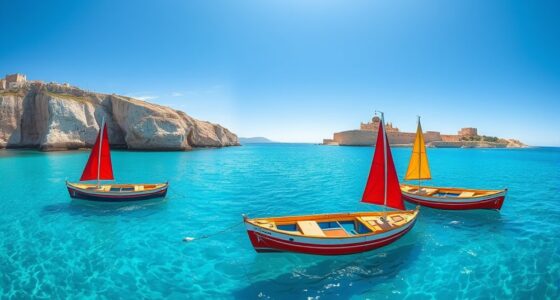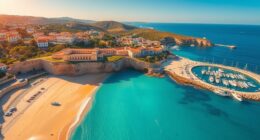Malta’s history and culture span thousands of years, from prehistoric temples and ancient civilizations to its strategic role in trade, Christianity, and medieval conflicts. You’ll find remarkable archaeological sites, like the Ġgantija temples, alongside medieval walls and Baroque architecture. The island’s resilience shone through during WWII, earning the George Cross for bravery. Today, Malta balances vibrant traditions with modern European influences, offering a rich tapestry of history and culture that you can explore further.
Key Takeaways
- Malta’s history spans from prehistoric temple construction to Roman, Arab, Norman, and British rule, shaping its diverse cultural heritage.
- The island is renowned for its ancient megalithic temples like Ħaġar Qim and Mnajdra, among the world’s oldest free-standing structures.
- Malta played a pivotal role in WWII, earning the George Cross for resilience during sustained Axis bombings.
- Its cultural identity blends ancient traditions, Christian influences, and modern European integration, reflected in architecture and societal values.
- UNESCO World Heritage sites, including Valletta and the Hypogeum, showcase Malta’s rich archaeological and architectural legacy.
Prehistoric Foundations of Malta

Have you ever wondered how Malta’s rich history began? It all started around 5900 BCE when the first human settlers arrived from Sicily. These early inhabitants, during the Għar Dalam phase, brought farming, pottery, and domesticated animals. They lived in caves like Għar Dalam Cave, where evidence shows they coexisted with dwarf elephants, hippos, and large swans now extinct. By 3500 BCE, Maltese society became more advanced, developing complex stone tools, fortified villages, and pottery. The arrival of the Bronze Age around 3000 BCE marked significant progress in farming, sculpture, and construction, exemplified by the Ġgantija temples—some of the world’s oldest free-standing structures. These prehistoric roots laid the foundation for Malta’s enduring cultural and historical legacy, with archaeological discoveries continuing to shed light on its ancient past.
The Phoenician and Carthaginian Era

During the Phoenician and Carthaginian era, Malta became a essential hub for maritime trade, connecting the islands with distant regions across the Mediterranean. You can see their religious and cultural influence in the temples and artifacts, which reflect the importance of deities like Astarte. This period laid the groundwork for Malta’s strategic significance and cultural continuity in the centuries that followed. Additionally, the introduction of multi-functional furniture and organized spaces during this era facilitated efficient trade and communal activities on the islands.
Maritime Trade Significance
The Phoenicians and Carthaginians transformed Malta into a crucial hub for Mediterranean trade through strategic maritime activities. They recognized Malta’s central location and used its natural harbors to facilitate commerce between North Africa, Sicily, Greece, and beyond. By establishing ports and trading outposts, they created a vibrant network of economic exchange. Carthaginians, in particular, used Malta as a naval base to control shipping routes and project power across the region. The island’s resources, such as timber and agricultural products, supported their maritime economy. Coins, pottery, and artifacts found on Malta testify to active trade and cultural interactions during this period. The strategic use of maritime infrastructure highlights Malta’s vital role in regional commerce and naval dominance during this era.
Religious and Cultural Influence
The Phoenician and Carthaginian eras left a lasting mark on Malta’s religious and cultural landscape, shaping its identity through practices, beliefs, and artistic expressions. You can see this influence in the construction of temples dedicated to goddess Astarte around 700 BC, reflecting deep religious devotion. Punic symbols and artifacts reveal a blend of local and Phoenician traditions, emphasizing trade and spirituality. The presence of religious sites and coin finds from this period shows how religion was intertwined with daily life and commerce. Carthaginian control from 539 BC further reinforced these cultural practices, leaving a legacy that persisted even after Roman conquest. Today, Malta’s archaeological sites and artifacts continue to testify to this vibrant, ancient religious and cultural heritage. The religious significance of these sites highlights the enduring power of faith and tradition in shaping Malta’s historical identity.
Roman Influence and Early Christianity
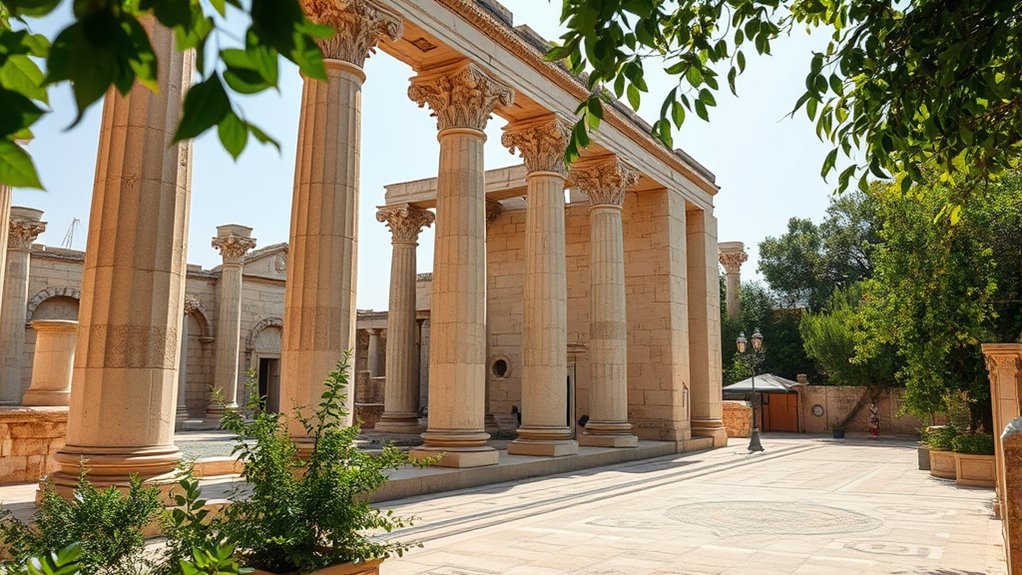
Roman influence profoundly shaped Malta’s development after 218 BC, when the islands peacefully surrendered to Roman forces. You’ll notice how Roman governance brought stability and urban development, especially in Mdina, which grew into a fortified city. Roman rule introduced new architecture, roads, and infrastructure that connected Malta to the wider empire. During this period, Christianity spread rapidly across the islands, especially after Emperor Constantine’s conversion in 312 AD. You can see evidence of this in early churches and Christian symbols found in archaeological sites. By the 4th and 5th centuries, Christianity was firmly established, replacing older pagan practices. This religious shift laid the foundation for Malta’s enduring Christian identity, which continues to influence its culture and traditions today. Additionally, the ongoing preservation of Roman and early Christian sites highlights the importance of archaeological heritage in understanding Malta’s rich history.
Byzantine, Arab, and Norman Transformations

Following the decline of Roman authority, Malta experienced a series of transformative rule changes that deeply shaped its culture and society. The Byzantines reasserted control in the 6th century, reintroducing Eastern Christian influence and administrative structures, which sustained Malta’s connection to Mediterranean trade networks. In the 9th century, Arab rule began, profoundly transforming Malta’s language, architecture, and governance. Arab settlers introduced new agricultural techniques, Islamic art, and the Maltese language, blending local and Islamic traditions. By the 11th century, Normans invaded, integrating Malta into the Latin Christian world. Norman rule brought renewed European ties, establishing the foundations for Christian institutions and feudal structures. These shifts created a rich cultural tapestry, blending Byzantine, Arab, and Norman influences that still echo in Malta’s identity today.
The Knights of St. John and the Renaissance
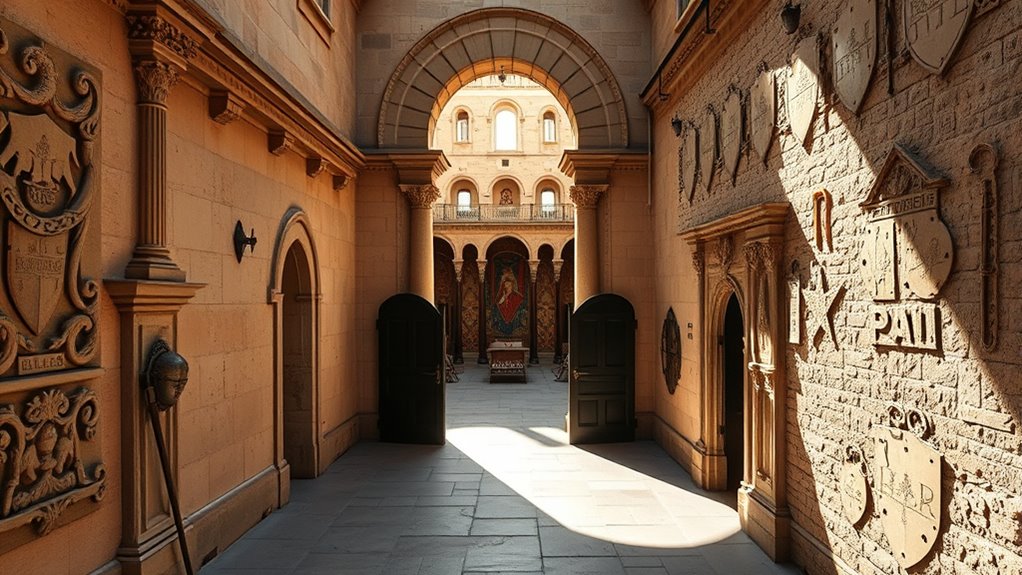
During the early modern period, the Knights of St. John arrived in Malta in 1530, granted the islands by Emperor Charles V. You witness them transforming Malta into a formidable fortress and naval hub. They built Valletta, a new fortified city, after the 1565 Great Siege, defending against Ottoman forces. Their influence spurred Baroque art, architecture, and culture, leaving a lasting legacy. The table below highlights their key contributions:
| Innovation | Cultural Impact | Military Achievements |
|---|---|---|
| Fortification systems | Baroque churches, palaces | Defeating Ottomans |
| Naval defenses | Artistic patronage | Establishing Malta as a naval base |
| Urban development | Renaissance influence | Maintaining Christian dominance |
| Religious orders | Architectural masterpieces | Strategic Mediterranean control |
Additionally, their innovative military strategies helped ensure Malta’s resilience in the Mediterranean.
Colonial Period Under the British

Did you ever wonder how Malta transformed under British rule? When the British took control in 1800, they turned Malta into a strategic naval base, essential for Mediterranean dominance. You’d see the construction of impressive fortifications and the development of Valletta into a bustling colonial hub. During World War II, you’d witness Malta’s resilience as it endured relentless Axis bombings, earning the George Cross for bravery. The British influenced Malta’s legal, educational, and infrastructural systems, shaping modern institutions. You’d also notice a growing push for independence, culminating in Malta’s self-governance in 1964. Throughout this period, Malta balanced its rich history with modernization efforts, laying the groundwork for its future as a republic and member of the European Union. Recognizing the colonial influence on Malta’s cultural identity helps explain the nation’s complex history and its ongoing efforts to forge a unique national identity.
Malta During World War II and Its Aftermath
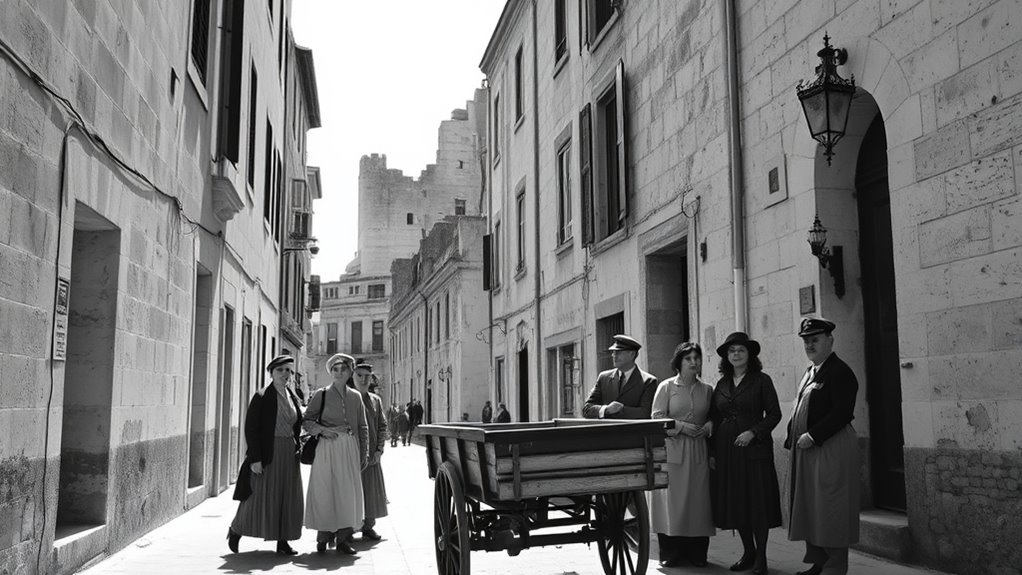
Malta’s strategic location made it a pivotal target in World War II, and its resilience became legendary. You witness firsthand how fierce Axis bombings targeted the island’s ports, airfields, and communities. Despite relentless attacks, the Maltese people refuse to surrender, demonstrating remarkable bravery and unity. The Royal Air Force and Allied forces use Malta as an essential base for operations in North Africa and the Mediterranean. You see how the island endures severe destruction, yet remains defiant. After the war, Malta faces economic hardships, rebuilding its shattered infrastructure. The bravery during the siege earns Malta the George Cross, symbolizing courage under fire. This period marks a turning point, shaping Malta’s national identity and strengthening its resolve for independence and sovereignty. Digital literacy programs have played a role in empowering the Maltese people to communicate and rebuild effectively in the post-war era.
Modern Malta: Independence and European Integration

After enduring the devastation of World War II and earning international recognition for bravery, Malta took significant steps toward shaping its future as an independent nation. In 1964, you saw Malta gain independence from Britain, marking a major milestone. You witnessed the progression from a colonial territory to a sovereign republic in 1974, while preserving your rich cultural traditions. Moving forward, you embraced European integration by joining the European Union in 2004, boosting your economy and strengthening political ties. This move aligned with your goals of modernization while maintaining your unique identity. Today, Malta balances its proud history with active participation in European affairs, reflecting resilience and a commitment to progress. Your country’s journey from colonial rule to a thriving, independent member of the EU highlights its dynamic evolution. Additionally, your nation has increasingly adopted modern economic and social policies, demonstrating its commitment to sustainable development and global engagement.
UNESCO Heritage Sites and Cultural Legacy

Malta’s rich cultural heritage is prominently showcased through its three UNESCO World Heritage Sites, each representing a unique chapter of the island’s history. Valletta’s historic center reflects the Baroque architecture and fortifications built by the Knights of St. John, symbolizing Malta’s strategic importance and artistic legacy. The Ħal Saflieni Hypogeum, an underground prehistoric temple complex, reveals Malta’s earliest religious practices and advanced engineering skills dating back thousands of years. The megalithic Temples of Malta, such as Ħaġar Qim and Mnajdra, are among the world’s oldest free-standing structures, showcasing prehistoric craftsmanship and spiritual expression. Visiting these sites allows you to witness Malta’s enduring legacy, blending ancient traditions with its vibrant modern culture, making the island a living museum of human history. Incorporating lint rollers into preservation efforts can help maintain the cleanliness of these historic sites, ensuring their longevity for future generations.
Frequently Asked Questions
How Did Malta’s Strategic Location Influence Its Diverse Cultural History?
Your strategic location in the Mediterranean made Malta a crucial crossroads for trade, conquest, and cultural exchange. You see how it attracted settlers, from prehistoric inhabitants to Phoenicians, Romans, Byzantines, Arabs, and Knights of St. John. Each group brought their customs, religion, and architecture, shaping Malta’s diverse heritage. Its position also made it a key naval base, influencing military conflicts and alliances that left a lasting cultural imprint.
What Are the Most Significant Archaeological Discoveries From Malta’s Prehistoric Period?
You’ll find that Malta’s prehistoric archaeological discoveries are truly the cream of the crop. The Għar Dalam Cave revealed early human settlements alongside extinct dwarf elephants and hippos, giving you a glimpse into ancient life. The megalithic temples, like Ġgantija, are the world’s oldest free-standing structures, showcasing advanced craftsmanship. These finds prove Malta’s long-standing importance, making it a treasure trove for anyone interested in early human history.
How Did Arab Rule Shape Malta’s Language and Architectural Traditions?
Arab rule profoundly influenced Malta’s language and architecture. You’ll notice the Maltese language, a Semitic tongue with Latin and Italian influences, stems from Arabic. Architecturally, you see Islamic elements like courtyards, arches, and decorative motifs in many historic buildings. These changes blend with local styles, creating a unique cultural landscape that reflects centuries of Arab presence, shaping Malta’s identity even today.
What Role Did the Knights of St. John Play in Mediterranean Geopolitics?
You see, the Knights of St. John played a pivotal role in Mediterranean geopolitics by defending Christian Europe from Ottoman expansion. They built strong fortifications like Valletta, turning Malta into a strategic naval base. Their efforts helped control essential maritime routes, ensuring safe passage for merchants and military ships. By engaging in battles like the Great Siege of 1565, they profoundly shaped regional power dynamics and maintained Christian dominance in the Mediterranean.
How Has Malta Balanced Modern Development With Its Historical Preservation Efforts?
You can see Malta walking the tightrope between modern growth and preserving its rich past. The government and local communities actively protect UNESCO sites like Valletta and the Megalithic Temples while encouraging sustainable development. They invest in adaptive reuse projects, blending old and new architecture seamlessly. This keeps the island’s historic charm alive, proving that progress and preservation can go hand in hand without one overshadowing the other.
Conclusion
So, after wandering through Malta’s centuries-long soap opera of invasions, rulers, and revolutions, you might think it’s a grand mosaic—except someone forgot to tell the stones they’re supposed to fit perfectly. Today, Malta’s rich heritage stands like a quirky museum exhibit that’s been left out in the sun a bit too long—beautiful, a little cracked, but undeniably unique. Just remember, in Malta, history isn’t just preserved; it’s practically still throwing a party.




